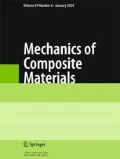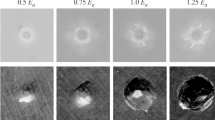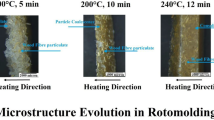The effect of drop-weight impact energy on the moisture diffusion coefficient and the limiting moisture saturation of next-generation GFRPs and CFRPs was investigated. The damage induced by a drop-weight impact decreased the compression strength and increased the moisture diffusion coefficient and the limiting moisture saturation of five tested polymer composite materials by 20-70% on the average. For describing the moisture uptake kinetics, the Langmuir model is found to be preferable, because the model with bonded and free water provided a coefficient of determination R 2 ≥ 0.998.

Similar content being viewed by others
References
ASTM Standard D7136, Standard Test Method for Measuring the Damage Resistance of a Fiber-Reinforced Polymer Matrix Composite to a Drop-Weight Impact Event (2005).
ASTM Standard D7137, Standard Test Method for Compressive Residual Strength Properties of Damaged Polymer Matrix Composite Plates. ASTM Int., West Conshohocken, PA (2012).
K. Berketis and D. Tzetzis, “The compression-after-impact strength of woven and non-crimp fabric reinforced composites subjected to long-term water immersion ageing,” J. Mater. Sci., 45, Iss. 20, 5611-5623 (2010).
K. Imielinska and L. Guillaumat, “The effect of water immersion ageing on low-velocity impact behavior of woven aramid-glass fiber/epoxy composites,” Compos. Sci. Technol., 64, Iss. 13-14, 2271-2278 (2004).
H. Saito and I. Kimpara, “Damage evolution behavior of CFRP laminates under post-impact fatigue with water absorption environment,” Compos. Sci. Technol., 69, Iss. 6, 847-855 (2009).
Y. Aoki, K. Yamada, and T. Ishikawa, “Effect of hygrothermal condition on compression after impact strength of CFRP laminates,” Compos. Sci. Technol., 68, Iss. 6, 1376-1383 (2008).
H. Park and C. Kong, “A study on low velocity impact damage evaluation and repair technique of small aircraft composite structure,” Composites: Pt A, 42, Iss. 9, 1179-1188 (2011).
K. E. Kutsevich, Adhesive Prepregs and CFRPs Based on Them. PhD thesis, Moscow (2014).
V. G. Zheleznyak, Binders for Polymer Composite Materials with Increased Fracture Toughness. PhD thesis, Moscow (2014).
R. R. Mukhametov, “Cyanate-ester binders for composite materials,” Euro-Asian Union of Scientists (EUS), No. 8, Pt. 5, 30-31 (2014).
N. F. Lukina, L. A. Dementyeva, and K. E. Kutsevich, “Adhesive prepregs based on Porcher fabrics — promising materials for parts and units made of PCM,” Proc. VIAM, No. 6 (2014).
A. E. Raskutin, “Structural CFRPs based on new binders of melt type and Porcher fabrics,” Nov. Materialoved. Nauka Tekhn., No. 5, 1-18 (2013).
I. I. Sokolov and A. E. Raskutin, “Carbon- and glass-fiber-reinforced plastics of new generation,” Proc. VIAM, No. 4, (viam-works.ru) (2013).
V. V. Subbotin and M. A. Grinev, “Application experience of FSUE VIAM and Porcher materials in the structures of units and parts of aircraft power plants made of polymer composite materials,” Nov. Materialoved. Nauka Tekhn., No. 5, 1-7 (2013).
J. Crank, The mathematics of Diffusion, Clarendonpress, Oxford, UK (1975).
A. V. Lykov, Theory of Thermal Conduction [in Russian], Vysshaya Shkola, Moscow (1967).
A. N. Aniskevich and Yu. O. Yanson, “Study of moisture absorption by an organoplastic,” Mech. Compos. Mater., 26, No. 4, 455-462 (1990).
A. N. Aniskevich and Yu. V. Ivanov, “Calculation of the moisture concentration field in a multilayered plate,” Mech. Compos. Mater., 30, No. 4, 364-370 (1994).
O. Startsev, A. Krotov, and G. Mashinskaya, “Climatic ageing of organic fiber reinforced plastics: water effect,” Int. J. Polym. Mater., 37, Iss. 3-4, 161-171 (1997).
O. V. Startsev, A. S. Krotov, O. G. Senatorova, L. I. Anihovskaya, V. V. Antipov, and D. V. Grashchenkov, “Sorption and diffusion of moisture in layered metal-polymer composite materials of “SIAL” type,” Materialoved., No. 12, 38-44 (2011).
O. V. Startsev, L. I. Anikhovskaya, A. A. Litvinov, and A. S. Krotov, “Increase in the reliability of predicting the properties of polymer composites in hygrothermal aging,” Dokl. Khim., 428, Iss. 1, 228-232 (2009).
L. T. Startseva, S. V. Panin, O. V. Startsev, and A. S. Krotov, “Moisture diffusion into fiberglasses after their climatic aging,” Dokl. Akad. Nauk, 456, No. 3, 305-309 (2014).
H. G. Carter and K. G. Kibler, “Langmuir-type model for anomalous moisture diffusion in composite resins,” J. Compos. Mater., 12, Iss. 5, 118-131 (1978).
P. Bonniau and A. R. Bunsell, “A comparative study of water absorption theories applied to glass epoxy composites,” J. Compos. Mater., 15, Iss. 5, 272-293 (1981).
T. I. Glaskova, R. M. Guedes, J. J. Morais, and A. N. Aniskevich, “A comparative analysis of moisture transport models as applied to an epoxy binder,” Mech. Compos. Mater., 43, No. 4, 377-388 (2007).
Acknowledgments
This study was financially supported by the Ministry of Education and Sciences of the Russian
Federation within the framework of Agreement on granting No. 14.505.21.0002 of 22.08.2014, identifier No. RFMEFI59514X0002, with the use of equipment of TsKP for climatic tests of FSUE VIAM.
Author information
Authors and Affiliations
Corresponding author
Additional information
Translated from Mekhanika Kompozitnykh Materialov, Vol. 51, No. 6, pp. 1081-1094 , November-December, 2015.
Rights and permissions
About this article
Cite this article
Startsev, V.O., Panin, S.V. & Startsev, O.V. Sorption and diffusion of moisture in polymer composite materials with drop-weight impact damage. Mech Compos Mater 51, 761–770 (2016). https://doi.org/10.1007/s11029-016-9547-6
Received:
Revised:
Published:
Issue Date:
DOI: https://doi.org/10.1007/s11029-016-9547-6




